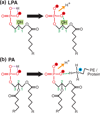Putting the pH into phosphatidic acid signaling
- PMID: 22136116
- PMCID: PMC3229452
- DOI: 10.1186/1741-7007-9-85
Putting the pH into phosphatidic acid signaling
Abstract
The lipid phosphatidic acid (PA) has important roles in cell signaling and metabolic regulation in all organisms. New evidence indicates that PA also has an unprecedented role as a pH biosensor, coupling changes in pH to intracellular signaling pathways. pH sensing is a property of the phosphomonoester headgroup of PA. A number of other potent signaling lipids also contain headgroups with phosphomonoesters, implying that pH sensing by lipids may be widespread in biology.
Figures




Similar articles
-
What makes the bioactive lipids phosphatidic acid and lysophosphatidic acid so special?Biochemistry. 2005 Dec 27;44(51):17007-15. doi: 10.1021/bi0518794. Biochemistry. 2005. PMID: 16363814
-
Phosphatidic acid is a pH biosensor that links membrane biogenesis to metabolism.Science. 2010 Aug 27;329(5995):1085-8. doi: 10.1126/science.1191026. Science. 2010. PMID: 20798321
-
Influence of Ca2+ on the surface behavior of phosphatidic acid and its mixture with diacylglycerol pyrophosphate at different pHs.Chem Phys Lipids. 2020 May;228:104887. doi: 10.1016/j.chemphyslip.2020.104887. Epub 2020 Feb 3. Chem Phys Lipids. 2020. PMID: 32027867
-
Phosphatidic acid in membrane rearrangements.FEBS Lett. 2019 Sep;593(17):2428-2451. doi: 10.1002/1873-3468.13563. Epub 2019 Aug 31. FEBS Lett. 2019. PMID: 31365767 Review.
-
Understanding of the roles of phospholipase D and phosphatidic acid through their binding partners.Prog Lipid Res. 2012 Apr;51(2):71-81. doi: 10.1016/j.plipres.2011.12.003. Epub 2011 Dec 28. Prog Lipid Res. 2012. PMID: 22212660 Review.
Cited by
-
Using membrane composition to fine-tune the pKa of an optical liposome pH sensor.J Mater Chem C Mater. 2016 Apr 14;4(14):2925-2930. doi: 10.1039/C5TC03480A. Epub 2015 Dec 1. J Mater Chem C Mater. 2016. PMID: 27087967 Free PMC article.
-
The Recombinant Sea Urchin Immune Effector Protein, rSpTransformer-E1, Binds to Phosphatidic Acid and Deforms Membranes.Front Immunol. 2017 May 12;8:481. doi: 10.3389/fimmu.2017.00481. eCollection 2017. Front Immunol. 2017. PMID: 28553283 Free PMC article.
-
How Chemical Nature of Fixed Groups of Anion-Exchange Membranes Affects the Performance of Electrodialysis of Phosphate-Containing Solutions?Polymers (Basel). 2023 May 12;15(10):2288. doi: 10.3390/polym15102288. Polymers (Basel). 2023. PMID: 37242863 Free PMC article.
-
Staphylococcal toxin PVL ruptures model membranes under acidic conditions through interactions with cardiolipin and phosphatidic acid.PLoS Biol. 2025 Apr 15;23(4):e3003080. doi: 10.1371/journal.pbio.3003080. eCollection 2025 Apr. PLoS Biol. 2025. PMID: 40233125 Free PMC article.
-
Role of phosphatidic acid lipids on plasma membrane association of the Ebola virus matrix protein VP40.Biochim Biophys Acta Mol Cell Biol Lipids. 2024 Apr;1869(3):159464. doi: 10.1016/j.bbalip.2024.159464. Epub 2024 Feb 14. Biochim Biophys Acta Mol Cell Biol Lipids. 2024. PMID: 38360201 Free PMC article.
References
Publication types
MeSH terms
Substances
Grants and funding
LinkOut - more resources
Full Text Sources

